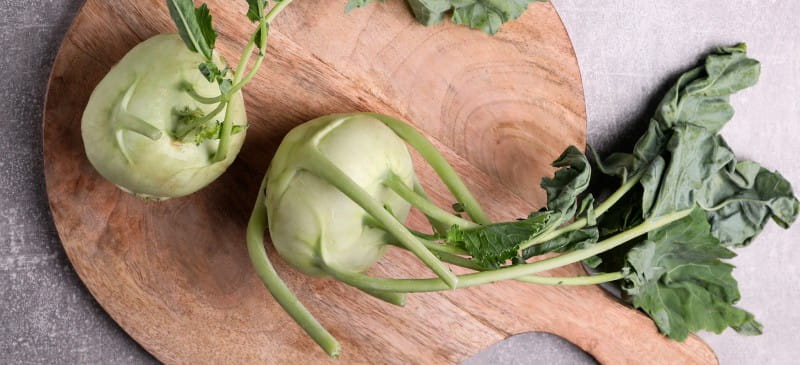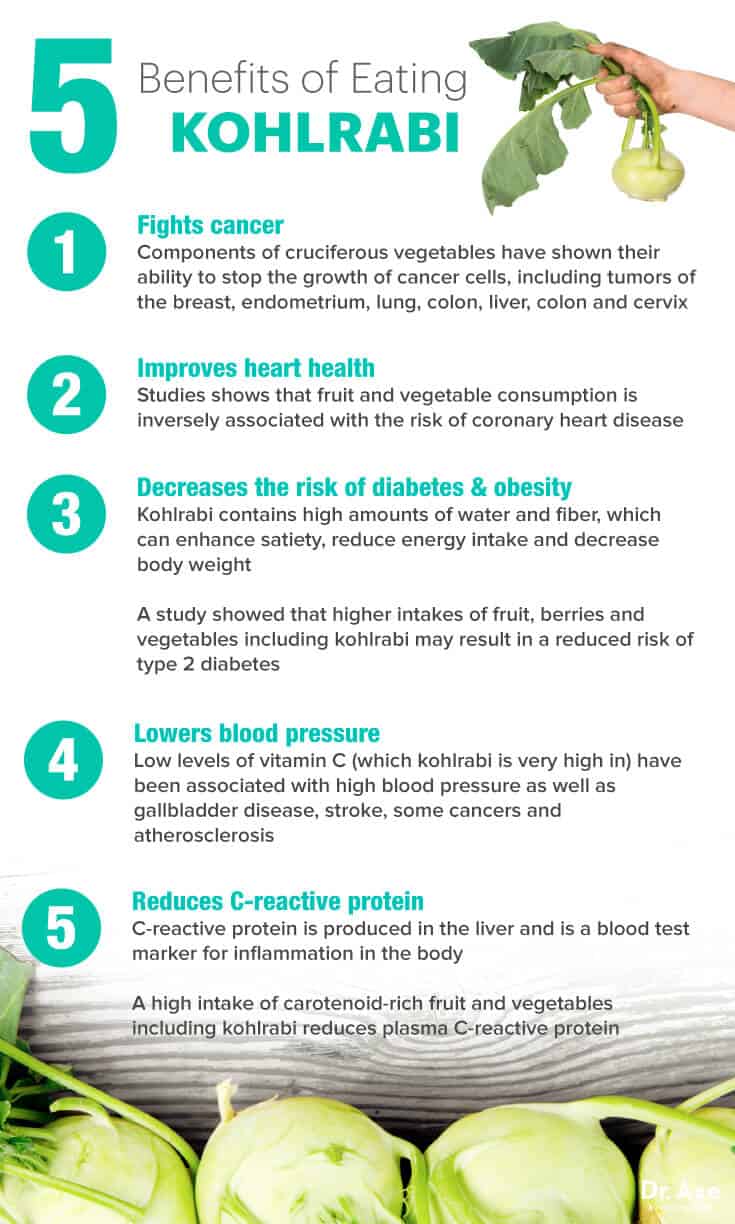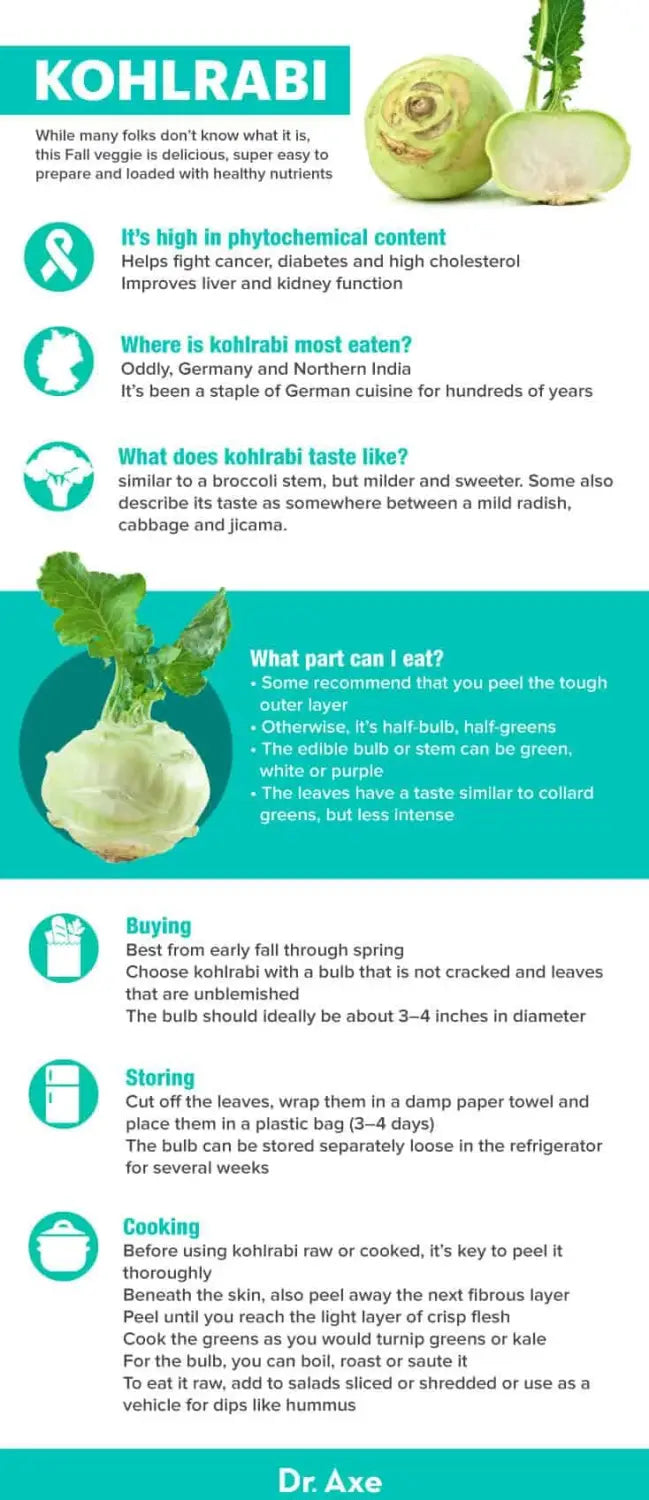The Benefits of Kohlrabi: A Delicious Superfood
 improving liver and kidney function. That's not all.
improving liver and kidney function. That's not all.
Kohlrabi is delicious, super easy to prepare and loaded with healthy nutrients. Notably, it’s one of the top vitamin C foods, with more than 100 percent of your daily vitamin C needs in just one cup of kohlrabi.
Research has shown that the phytochemical content of kohlrabi makes it a powerhouse when it comes to fending off cancer, diabetes and high cholesterol while improving liver and kidney function. That’s not all.
What Is Kohlrabi?
You may have spotted kohlrabi at your local farmers market and wondered what on earth it was. More recently, it has made its way to mainstream grocery store shelves, so thankfully it should be easier to find after you read this article (and you’ll definitely know what it is now).
What does it taste like? The taste of kohlrabi is similar to a broccoli stem but milder and sweeter. Some also describe its taste as somewhere between a mild radish, cabbage and jicama.
It is a member of the same family (Brassicaceae) as the more well-known likes of kale, Brussels sprouts, broccoli and cauliflower. The whole kohlrabi plant is edible, minus its slender root.
The kohlrabi you purchase most likely is half bulb, half greens. The edible bulb or stem can be green, white or purple, depending on the variety.
The leaves have a taste similar to collard greens but less intense. Like its relatives, it is loaded with phytochemicals that help prevent damage to the cells of our bodies and improve our overall health.
Kohlrabi is not widely grown commercially, but consumers are gaining awareness of this versatile vegetable. In Germany, however, kohlrabi has been a staple of German cuisine for hundreds of years. The German translation of kohlrabi is “cabbage turnip.”
It has also become a vegetable staple in northern India.
There are several varieties of kohlrabi commonly grown, including:
- White Vienna
- Purple Vienna
- Grand Duke
- Gigante (also known as “Superschmelz”)
- Purple Danube
- White Danube
The coloration of the purple types is just superficial — the edible parts are all pale yellow.
Kohlrabi Nutrition Facts
Kohlrabi (Brassica oleracea) is technically a form of cabbage. It’s native to Europe and is sometimes called a “German turnip.”
One cup (about 135 grams) of raw kohlrabi contains roughly the following:
- 36.5 calories
- 8.4 grams carbohydrates
- 2.3 grams protein
- 0.1 grams fat
- 4.9 grams fiber
- 83.7 milligrams vitamin C (140 percent DV)
- 473 milligrams potassium (14 percent DV)
- 0.2 milligrams vitamin B6 (10 percent DV)
- 0.2 milligrams copper (9 percent DV)
- 0.2 milligrams manganese (9 percent DV)
- 25.6 milligrams magnesium (6 percent DV)
- 62.1 milligrams phosphorus (6 percent DV)
- 0.1 milligrams thiamine (5 percent DV)
- 21.6 micrograms folate (5 percent DV)
Meanwhile, one cup (approximately 165 grams) of boiled kohlrabi nutrition has about:
- 47.8 calories
- 11 grams carbohydrates
- 3 grams protein
- 0.2 grams fat
- 1.8 grams fiber
- 89.1 milligrams vitamin C (149 percent DV)
- 561 milligrams potassium (16 percent DV)
- 0.3 milligrams vitamin B6 (13 percent DV)
- 0.2 milligrams manganese (12 percent DV)
- 0.2 milligrams copper (11 percent DV)
- 31.3 milligrams magnesium (8 percent DV)
- 74.2 milligrams phosphorus (7 percent DV)
- 19.8 micrograms folate (5 percent DV)
- 0.9 milligrams vitamin E (4 percent DV)
- 0.1 milligrams thiamine (4 percent DV)
- 41.2 milligrams calcium (4 percent DV)
- 0.7 milligrams iron (4 percent DV)
Kohlrabi Health Benefits
1. Helps Fight Cancer
Kohlrabi is a member of the champion cancer-fighting family of cruciferous vegetables. Components of cruciferous vegetables have shown their ability to stop the growth of cancer cells, including tumors of the breast, endometrium, lung, liver, colon and cervix.
A unique aspect of cruciferous vegetables is that they are rich sources of sulfur-containing compounds known as glucosinolates. These support detoxification and the production of indole-3-carbinol and isothiocyanates, which greatly reduce the risk of breast, colon and lung cancer.
These powerful compounds that kohlrabi contains make it a strong cancer-fighting food, as these compounds help prevent cancer by enhancing the elimination of carcinogens before they can damage DNA or by altering cell-signaling pathways in ways that help prevent normal cells from being transformed into cancerous cells.
An extensive review of epidemiological studies reported that the majority (67 percent) of 87 case-control studies found an inverse association between some type of cruciferous vegetable intake and cancer risk.
2. Supports Heart Health
Diets containing kohlrabi and other nutrient-rich veggies protect you against cardiovascular disease. A large study of adults ranging in age from 25 years to 74 years revealed that there is an inverse association of fruit and vegetable intake with the risk of cardiovascular disease and all-cause mortality in the general U.S. population.
In the Journal of Nutrition, a meta-analysis of cohort studies found that fruit and vegetable consumption is inversely associated with the risk of coronary heart disease.
3. Helps Decrease the Risk of Diabetes and Obesity
Like other fruits and veggies, kohlrabi contains high amounts of water and fiber, which can enhance satiety, reduce energy intake and, consequently, decrease body weight. Since obesity is one of the main risk factors for type 2 diabetes, by preventing obesity through a healthy diet that includes greens like kohlrabi, you can directly decrease your likelihood of developing diabetes.
If you have the disease already, you can begin to lessen your need for blood sugar-regulating medications by improving your diet with the inclusion of more vegetables like kohlrabi.
One study of 2,332 Finnish men indicates that higher intakes of fruit, berries and vegetables, including kohlrabi, may result in a reduced risk of type 2 diabetes.
4. May Help Lower Blood Pressure
High blood pressure (hypertension) is a common health condition in which the long-term force of the blood against your artery walls is high enough that it may eventually cause health problems like heart disease, heart attack and stroke. Scary fact: You can have high blood pressure for years without even knowing it because there aren’t always obvious symptoms.
One of the best natural ways to lower blood pressure is through your diet. A healthy diet high in foods like kohlrabi is crucial when it comes to lowering blood pressure to a healthy place.
Research indicates that low levels of vitamin C are associated with high blood pressure as well as gallbladder disease, stroke, some cancers and arteriosclerosis. By getting enough vitamin C from your diet with fresh foods like kohlrabi, you may help reduce the risk of developing high blood pressure and other serious health issues.
5. Can Reduce C-Reactive Protein
C-reactive protein is produced in the liver and is a blood test marker for inflammation in the body. It’s one of a group of proteins called “acute phase reactants” that goes up in response to disease-causing inflammation.
A study published in the American Journal of Clinical Nutrition investigated the effects of low, medium and high intakes of vegetables and fruit on markers of immune functions, including nonspecific markers of inflammation. The study found that a high intake of carotenoid-rich foods, including kohlrabi, reduces plasma C-reactive protein.
The lower your level of C-reactive protein, the lower your risk for cardiovascular disease and other serious inflammatory health issues. — another great reason to include lots of kohlrabi in your diet regularly!
Related: Mustard Greens Nutrition, Health Benefits & Recipes
Storing and Cooking
Kohlrabi is a cool-weather crop, which means that it’s at its best from early fall through spring. You can usually find it at your local farmers market or health food market.
Choose one with a fresh bulb that is not cracked and leaves that are unblemished. The bulb should ideally be about three to four inches in diameter.
When it comes time to store kohlrabi at home, cut off the leaves, wrap them in a damp paper towel and place them in a plastic bag. The leaves can then be stored in the refrigerator for three to four days.
The bulb can be stored separately loose in the refrigerator for several weeks. You know the bulb has been in the fridge too long when it begins to feel soft.
As with any fresh food, the sooner you use it, the better it will be.
Before using it raw or cooked, it’s key to peel it thoroughly. Beneath the thick, hard skin of the bulb is another fibrous layer, which should also be peeled away. Peel until you reach the light layer of crisp flesh.
If you can get it with the greens attached, you can cook the greens as you would turnip greens or kale. When it comes to the bulb, cooking methods include steaming, boiling, roasting or sautéing.
Cooking the bulb and leaves will change the texture. If you want it to keep a crunchy, crisp texture for salads or side dishes, then keep it raw. If you prefer a tender, softer texture, then cook up the stems and bulbs instead.
There are so many ways to use kohlrabi at home. It can be added to salads, stews, soups and stir-fry dishes. Add it to salads sliced or shredded, or cut it up and use it has a vehicle for dips like hummus.
Kohlrabi Recipes
Are you looking for tips on preparing kohlrabi bulbs, stems and leaves after finding a fresh plant at the farmers’ market?
Substitute kohlrabi leaves for kale in this recipe for Massaged Kale Salad, and in 10 minutes you will have a delicious side dish or snack loaded with nutrients and flavor. You can use the bulb and make some Kohlrabi Homefries browned in a small amount of oil and seasoned with some tasty spices.
Also, try a mouthwatering, vegetable-centric dish: healthy and super-satisfying Curried Cauliflower Soup that includes kohlrabi!

Risks and Side Effects
If you know that you have a food allergy or sensitivity to another cruciferous veggie, then check with your doctor before consuming kohlrabi.
An allergy to this vegetable is not common, so most likely it shouldn’t cause any negative side effects.
Conclusion
- Kohlrabi is a veggie that’s less known than others but can be found at many local farmers markets. It’s a nutrient-rich plant, and the leaves, stems and bulbs can all be consumed for a slightly sweet, earthy flavor.
- Research has shown that the phytochemical content of kohlrabi makes it a powerhouse when it comes to fending off cancer, diabetes and high cholesterol while improving liver and kidney function.
- It also improves heart health, decreases the risk of obesity, lowers blood pressure and decreases C-reactive protein, which can benefit the heart.
- There are many ways to incorporate this health-promoting food into your diet. It can be added to salad, stews, soups and stir-fry dishes, and it can be used raw, too.





Leave a comment